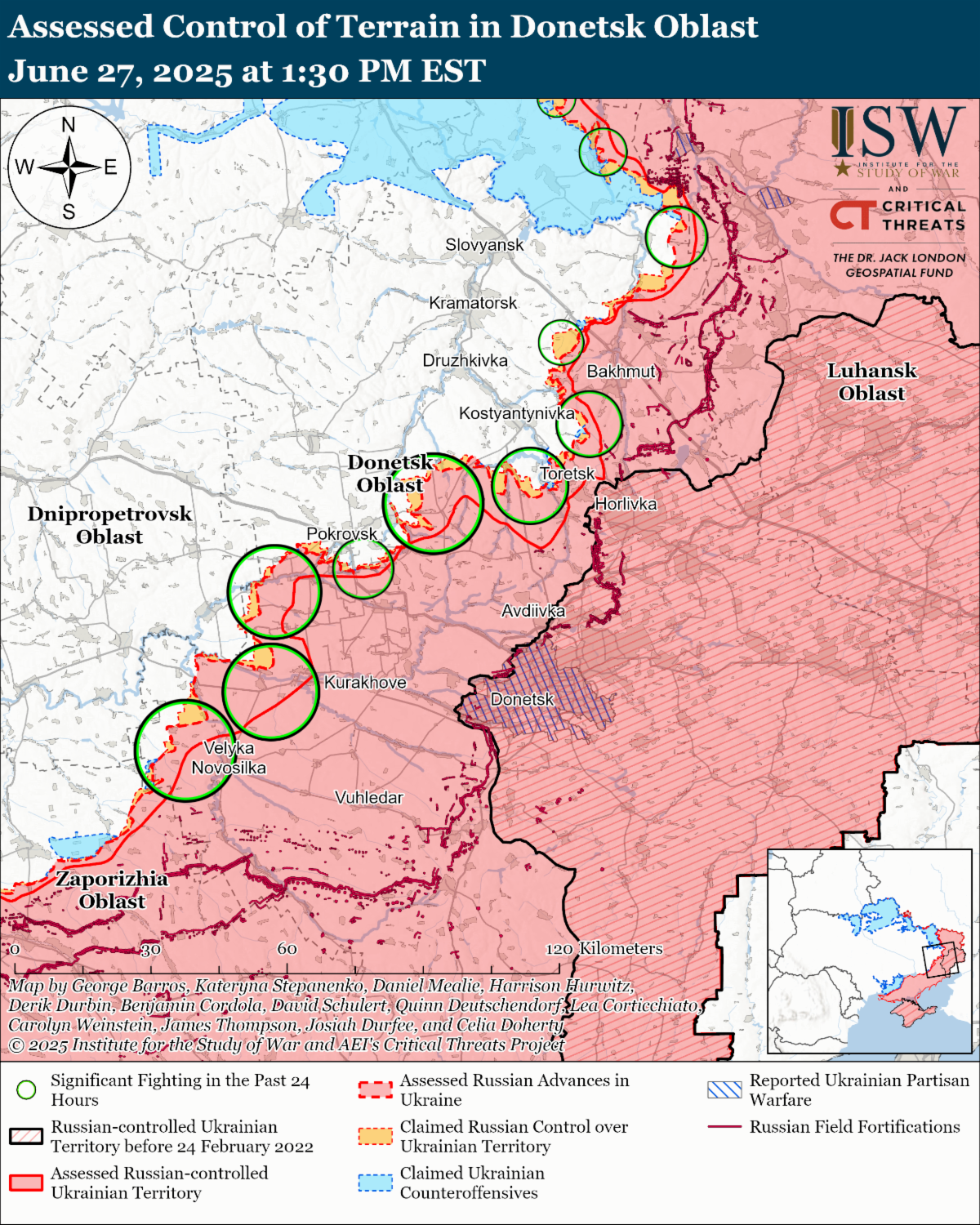The Kremlin continues to downplay the social and economic costs of Russia's war in Ukraine and inflated military spending. Russian President Vladimir Putin told journalists on June 27, following the Eurasian Economic Union (EAEU) summit in Minsk, that sanctions cannot hurt Russia’s economy and that Russia's economic indicators are “satisfactory.” Putin acknowledged that Russia’s economy is still contending with high inflation and that Russia’s economic growth in 2025 will be “much more modest to combat inflation.” Putin also claimed that Russia’s military budget is currently 6.3 percent of its GDP, or 13.5 trillion rubles (roughly $172 billion), and that Russia plans to steadily decrease defense spending beginning in 2026. Russia notably increased its defense budget by 25 percent between the 2024 and 2025 federal budgets and has been increasing its investments in Russia's defense industry throughout 2025.
Putin’s statements likely seek to portray the Russian government as committed to social and civilian expenditures and to downplay recent indicators of the societal and economic toll of Russia’s war against Ukraine and corresponding prioritization of military-industrial sector investment. Russian officials previously claimed that the 2025-2027 federal budgets would prioritize civilian and social sector investments, despite the September 2024 draft budgets indicating Russia will spend roughly 41 percent of its annual expenditures in 2025 on national security and defense. The Russian Finance Ministry more than tripled its budget deficit target for 2025 in May – from 0.5 percent of Gross Domestic Product (GDP) to 1.7 percent of GDP – after several months of staggeringly low oil and gas profits. Russian Central Bank Chairperson Elvira Nabiullina notably stated at the St. Petersburg International Economic Forum (SPIEF) on June 19 that Russia has exhausted many of its “free resources“ since the start of Russia‘s full-scale war against Ukraine, including Russia’s workforce, production and import substitution capacities, and reserves of the National Welfare Fund and Russia’s banking sector. Russia’s military force generation strategy currently hinges on large recruitment and pension payouts, and it remains unclear how the Kremlin intends to fund these payments in the medium- to long-term, as Russia reportedly depleted the entire 2025 federal recruitment budget fund between January and March 2025. Russia is also making significant financial investments in its domestic drone production capacity and committed 243 billion rubles (about $3 billion) to Russian drone companies between 2023 and 2024. Any sharp decrease in Russia's defense spending will likely depress the Russian economy in the medium term, as Russia’s defense industrial base now accounts for a significant portion of overall Russian domestic production.
Putin also reiterated Kremlin narratives aimed at discrediting Ukraine and blaming the West and NATO for his decision to invade Ukraine. Putin claimed that Russia has agreed to conduct a third round of negotiations, is ready to meet with Ukraine in Istanbul, and has demonstrated its willingness to negotiate through prisoner of war (POW) and killed-in-action (KIA) exchanges. Putin claimed that Ukraine is refusing to accept the bodies of some deceased servicemembers, an unsubstantiated claim that is part of an ongoing Russian information campaign depicting Ukraine as spoiling POW exchanges and KIA repatriations in order to provoke discontent and demoralize Ukrainian society and to discredit the Ukrainian government. Putin reiterated Russia's long-term claim that NATO promised Russia it would never expand east and claimed that Russia was "crudely deceived." Putin claimed that Western countries in opposition to Russia will "soon die" themselves. Putin also reiterated that Russia will only conclude its war against Ukraine on Russia’s terms and claimed that Russian defense spending is designed to achieve this goal. ISW has previously noted that Russia’s terms – the "denazification" and "demilitarization" of Ukraine, which Russia has demanded since the start of the full-scale invasion in February 2022 – amount to demands for regime change, the installation of a pro-Russian proxy government in Ukraine, and significant limitations on Ukraine's ability to defend itself against future Russian aggression.
Key Takeaways:
- The Kremlin continues to downplay the social and economic costs of Russia's war in Ukraine and inflated military spending.
- Putin’s statements likely seek to portray the Russian government as committed to social and civilian expenditures and to downplay recent indicators of the societal and economic toll of Russia’s war against Ukraine and corresponding prioritization of military-industrial sector investment.
- Putin also reiterated Kremlin narratives aimed at discrediting Ukraine and blaming the West and NATO for his decision to invade Ukraine.
- Open-source data suggests that Russia is increasingly investing in its defense industry and expanding its drone, infantry fighting vehicles (IFVs), and aircraft production and shipbuilding capabilities – several of the key platforms that Russia would likely rely on in a future war with NATO.
- Russia's ongoing efforts to expand drone production are having a more immediate impact on the frontline in Ukraine, although Russia will continue to benefit from enhanced drone production capabilities during any future conflict.
- Russian forces continue to implement tactical innovations that correspond with technological weapons system advancements.
- Russia continues to use chemical weapons against Ukrainian forces and civilians in direct violation of the Chemical Weapons Convention (CWC), of which Russia is a signatory.
- Ukrainian forces advanced near Lyman. Russian forces advanced in western Zaporizhia Oblast and near Kupyansk, Toretsk, and Pokrovsk.
| 




 [ISW] 이란 업데이트, 2025년 6월 27일
[ISW] 이란 업데이트, 2025년 6월 27일
 [ISW] 러시아군 생성 및 기술 적응 업데이트 2025년 6월 27일
[ISW] 러시아군 생성 및 기술 적응 업데이트 2025년 6월 27일